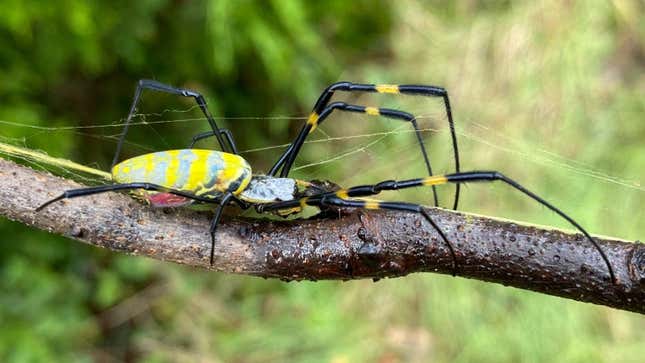
Joro spiders have inhabited parts of the U.S. southeast for the past nine years, but new research suggests these impressive arachnids will soon establish a presence along most of the eastern seaboard. Perhaps surprisingly, scientists aren’t too concerned, as these spiders are actually kinda awesome.
New research in Physiological Entomology presents evidence showing that Joro spiders (Trichonephila clavata) are capable of withstanding the harsh winter temperatures found along much of the U.S. East Coast, and that residents in these areas can expect to see an influx of these creatures in the coming years. Native to Japan, Korea, Taiwan, and parts of China, the spider arrived in the U.S. southeast in 2013, occupying parts of Georgia and South Carolina. The scientists behind the study say Joro spiders don’t represent a threat, whether to the local ecology or humans, and that we’ll simply need to get used to them.
“There’s really no reason to go around actively squishing them,” Benjamin Frick, a co-author of the study and an undergraduate researcher at the University of Georgia, told UGA Today. “Humans are at the root of their invasion. Don’t blame the Joro spider.”
Female Joro spiders are visually stunning, featuring long black legs highlighted with yellow streaks and large bodies colored in blue, yellow, and red. They’re also known for casting bright, golden webs. Adult females can grow to between 17 and 25 millimeters in size, while males are smaller, at between 7 and 10 mm. Joro spiders are relatively harmless, and they won’t bite unless threatened. And even then, their fangs aren’t often big enough to pierce human skin.

Scientists don’t know much about Joro spiders in terms of how they’ve adapted to their new American habitats. That said, the golden silk spider (Trichonephila clavipes), a closely related species that belongs to the same genus, has likewise taken root in the U.S. southeast, though it did so 160 years ago. This tropical spider hasn’t spread much beyond the southeast, as it can’t handle the cold. The purpose of the new study was to conduct a biological comparison of the two spiders to determine if Joro spiders might likewise be confined to the southeast. The answer, as the scientists learned, is no.
Frick, along with study co-author Andy Davis, a research scientist at the Odum School of Ecology at the University of Georgia, analyzed records submitted to iNaturalist.org, allowing them to compare the spiders’ seasonal spread and timing (iNaturalist uses publicly submitted reports to build location data for a variety of species). They examined actual specimens, taking measurements of their metabolism and heart rates to evaluate their environmental tolerances. And to assess survivability, the researchers exposed the spiders to freezing temperatures during two-minute-long stints.
This revealed that Joro spiders have a shorter season than golden silk spiders, “indicating it can complete its lifecycle within a narrow period of suitable weather,” according to the study. Also, Joro spiders have a metabolism that’s twice as high as their cousins, and their heart rate is 77% higher when exposed to low temperatures. What’s more, nearly three-quarters of Joro spiders survived sub-zero temperatures compared to half of the golden silk spiders. These results “suggest the joro spider can exist in a colder climatic region than the southeastern USA, which can be useful information for management or planning purposes,” wrote the scientists in their paper.
The northern spread of Joro spiders, it would seem, is inevitable. These spiders thrive in areas of Japan that compare to the U.S. eastern seaboard, and they spread using a technique called “ballooning,” in which they use the wind to carry them to new locations, in a pattern that repeats with each generation. It’s also likely that humans will continue to inadvertently spread them as well, such as on transport trucks or inside luggage.
But Frick and Davis aren’t concerned, saying Joro spiders don’t exert too much of an effect on local foodwebs and ecosystems, and that they might actually represent a new food source for some predators, especially birds. Both Frick and Davis advise that people simply leave the arachnids alone.
“People should try to learn to live with them,” said Davis. “If they’re literally in your way, I can see taking a web down and moving them to the side, but they’re just going to be back next year.” To which Frick added: “The way I see it, there’s no point in excess cruelty where it’s not needed.”
We’re used to seeing invasive species as being something negative, but by all appearances, the Joro spider might actually add to the ecological diversity of North America. Time will tell.